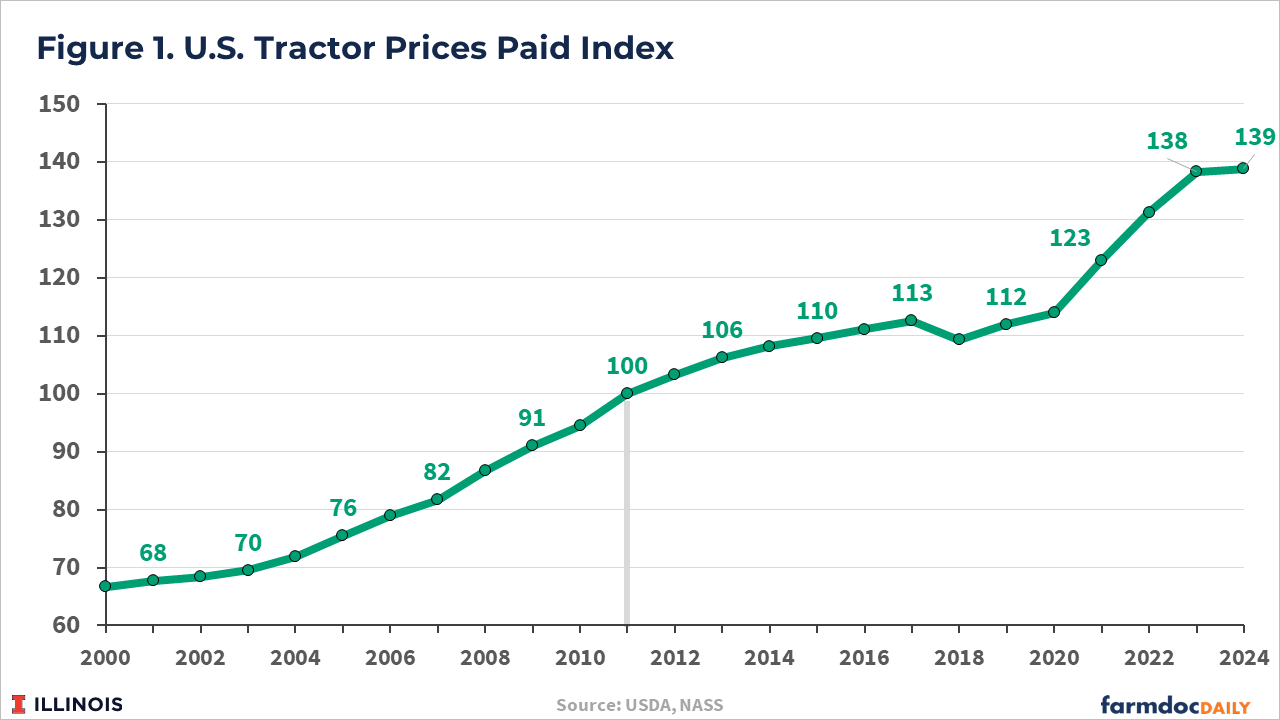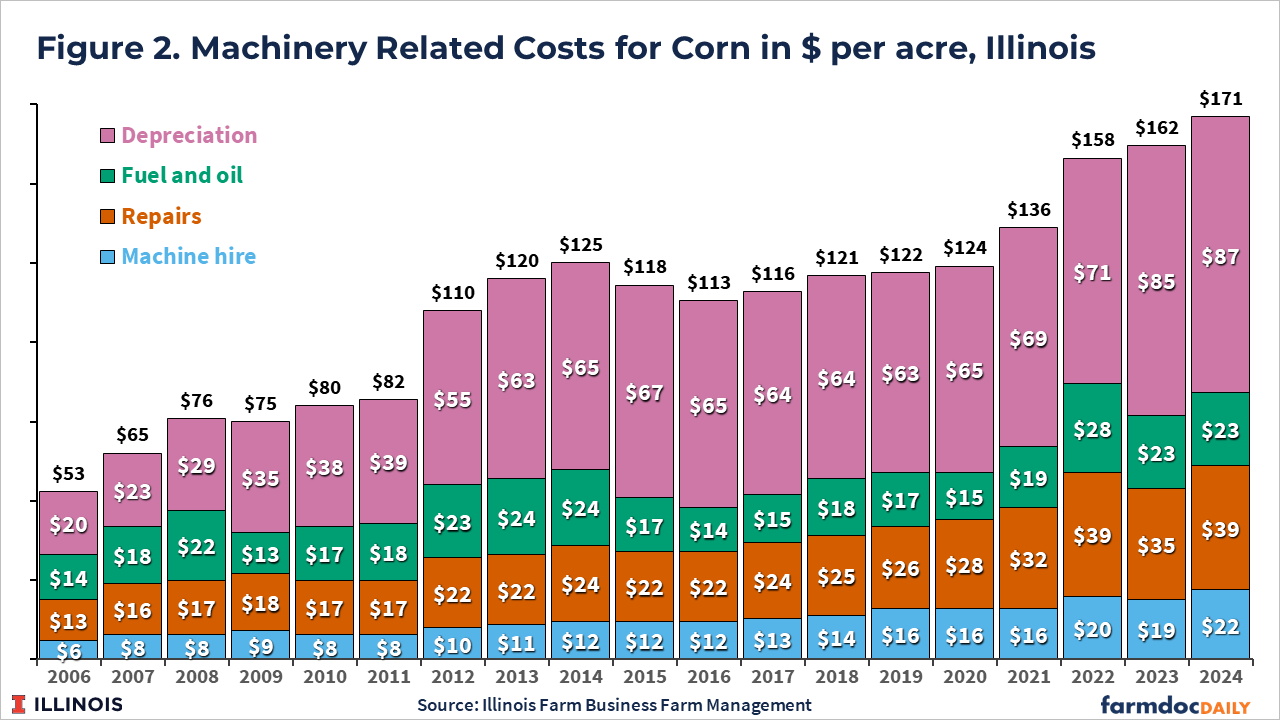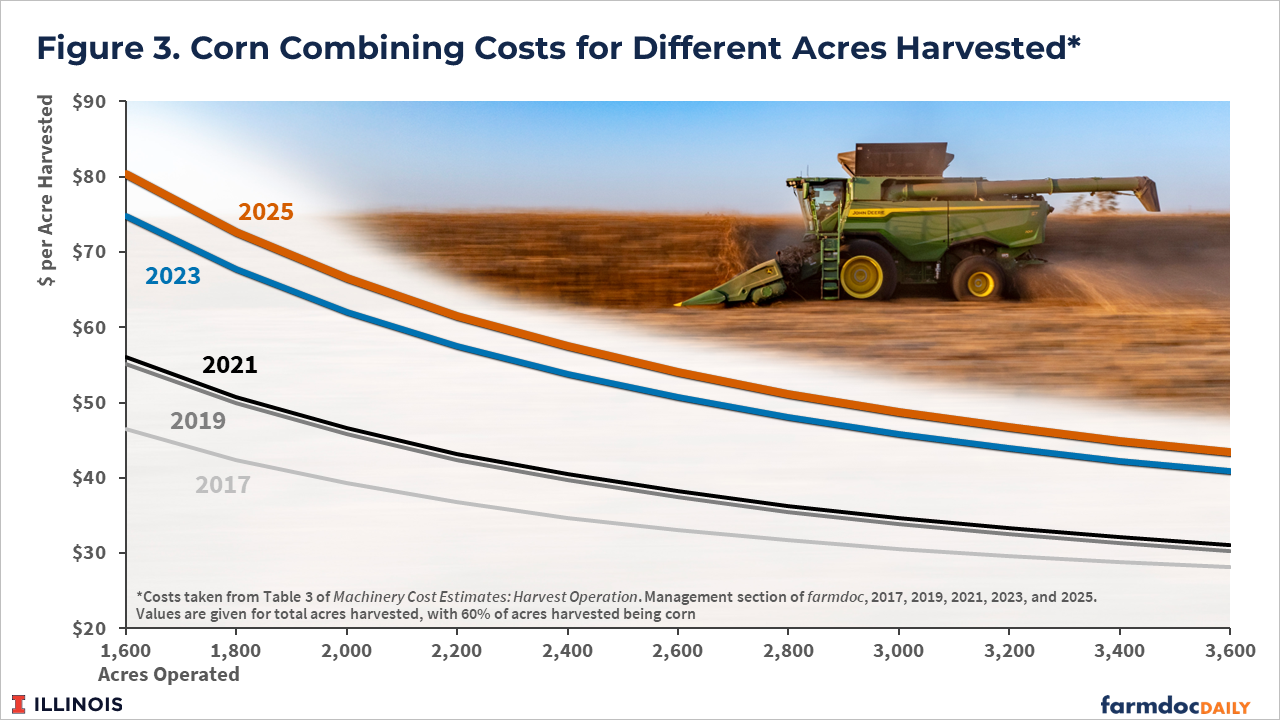Large Increase in Machinery Costs Suggests Need to Reconsider Machinery Purchase Decisions
Between 2021 and 2023, prices of new agricultural equipment increased by over 20%, resulting in similar increases in machinery costs on farms. To remain competitive, farmers may wish to reassess machinery management strategies, particularly when older machinery needs to be replaced. Combines typically represent the single largest investment on farms. Harvesting over 3,000 acres per combine will lower costs. The number of tractors, tillage implements, and planters also significantly impact costs.
Increases in Machinery Prices and Costs
An index of tractor prices paid, calculated by the National Agricultural Statistics Service (NASS), illustrates the increase in tractor prices over time (see Figure 1). While Figure 1 is specific to tractors, similar increases have occurred for many agricultural machines. Over time, tractor prices have continued to increase, but gains were relatively modest between 2011 and 2020. The tractor price index was 100 in 2011, the base year of the index. The index increased to 114 in 2020, representing a 14% rise over the nine years from 2011 to 2020. Much larger increases occurred in 2021 through 2023:
- 2021: The index increased from 114 to 123, an increase of 8%,
- 2022: The index increased from 123 to 131, an increase of 7%, and
- 2023: The index increased from 131 to 138, an increase of 5%.
From 2020 to 2023, tractor prices increased by 21%, compared to 14% from 2011 to 2023.
Those significant price increases correspond with supply chain challenges which arose during the COVID pandemic and a general rise in inflation, which continues to this day. Labor shortages have also occurred. Continuing supply disruptions caused by trade disputes are likely to persist and further increase costs. Machine manufacturers have also reduced output due to concerns about generally lower demand for machinery resulting from lower grain farm incomes.
Increases in machine prices are a large contributor to machinery-related costs on Midwest farms. Figure 2 shows per-acre machinery costs summarized from farms enrolled in Illinois Farm Business Farm Management on central Illinois farms growing corn on high-productivity farmland. Machine-related costs include:
- Depreciation represents an economic charge for the use of machinery. Depreciation costs increased from $69 per acre in 2021 to $87 in 2024.
- Fuel and oil increased from $19 per acre in 2021 to $23 in 2024.
- Repairs increased from $32 per acre in 2021 to $39 in 2024.
- Machine hire increased from $16 per acre in 2021 to $22 in 2024.
Overall, machinery-related costs have increased from $136 per acre in 2021 to $171 per acre in 2024, representing a 25% rise, roughly in line with the price increase reflected in USDA’s tractor price index. Other factors contributing to those increases were rising interest rates. Repair costs have also increased due to general price inflation and difficulties in filling machinery-related service positions.
Reassess Combine Decisions
Machinery management decisions may need to be reassessed due to these higher costs, particularly as machinery needs to be preplaced. A prime area for consideration is relative to combines. On most farms, combines represent the single largest machinery investment, and harvest costs often equal more than 50% of total machinery-related costs. Per-acre combine costs are directly related to the number of acres harvested with each combine.
Machinery costs are estimated by staff in the Department of Agricultural Economics every other year. Current machinery costs for 2025 are available in the management section of farmdoc. As part of that effort, we estimate the costs of operating combines for different acres harvested. The 2025 costs for different acres harvested are shown in Figure 3. Also, shown are costs for previous years’ estimates: 2017, 2019, 2021, 2023, and 2025. All costs shown in Figure 3 are calculated based on the purchase of new machines, and 60% of the harvested acres are corn. At 3,600 total acres harvested, indicating 2,160 corn acres (3,600 x 0.60) and 1,440 soybean acres are harvested. The cost of combining corn is $43.40 per acre. Costs of combining soybeans given 3,600 acres is $42.90 per acre.
Several items to note from the machinery costs in Figure 3. Substantial cost increases occurred between 2021 and 2023. At 3,600 acres harvested, corn combining costs were $31.10 per acre in 2021 vs. $40.90 per acre in 2023, an increase of $9.80 per acre, or 31%.
The list price of the combine used to estimate costs increased from $587,000 in 2021 to $741,000 in 2023, representing a 26% increase. From 2021 to 2023, interest rates used in the calculations rose from 4.5% to 5.5%, and diesel prices increased from $2.75 per gallon to $3.50 per gallon.
Second, the decline in cost per acre as acres increase is more pronounced in 2023 and 2024 than in 2021 and the early years. Take, for example, the costs for harvesting 2,600 and 3,600 acres. In 2021, the costs were $38.20 per acre for 2,600 acres and $31.10 per acre for 3,600 acres. The 1,000-acre increase resulted in a $7.10 decline in per-acre combine costs. In 2024, a 1,000-acre increase in harvested acres results in a $10.70 per acre decrease, from $54.10 per acre at 2,600 acres to $43.40 at 3,600 acres.
Finally, costs are significantly higher in 2025 compared to the years before 2021. In 2025, combine costs are $43.40 per acre at 3,600. In 2017, all acres harvested above 1,700 had costs lower than $43.40.
The number of acres has become more critical since 2021. The values in Figure 3 suggest significant cost disadvantages for those harvesting less than 3,000 acres with a combine. For farms above 3,000 acres, combining more acres can result in lower costs.
Harvesting more than 3,000 acres can be achieved in several ways:
- Farms with less than 3,000 acres could form a partnership and own a combine jointly. For example, two 2,000-acre farms could own one combine and harvest 4,000 acres, resulting in significantly lower costs than having two combines. Obviously, that situation would require cooperation and sharing of machinery agreements. Given today’s economic conditions, those savings may well be worthwhile.
- Some farms that operate over 3,000 acres can achieve much of the savings. Still, the farms with 3,000 acres could agree to cooperate and achieve savings. For example, three farms with 3,000 acres may have three combines. Combining operations so 9,000 acres are harvested with two combines instead of three would result in significant cost savings.
- Some farms with fewer acres may consider having acres custom-harvested. If the individual performing the custom operation has over 3,000 acres with the custom harvested acres, significant cost savings can occur, resulting in lower costs for both operations.
Other Machinery Decisions
Other machinery decisions also may change:
- The number of relatively new tractors a farm owns will significantly impact costs. For example, farms that have two tractors that are less than ten years old will have an advantage over a similarly sized farm with three tractors.
- Similarly, the amount of tillage equipment will influence costs. A farm with two relatively new tillage implements will face a cost advantage over a farm with three or more implements.
- The number of planters also influences costs. Many farmers now have two planters, allowing them to plant soybeans and corn simultaneously. Yield advantages may come from simultaneous planting, but the costs of owning two planters have increased in recent years. Re-evaluating the advisability of owning two planters may be warranted.
Summary
The supply chain impacts of COVID-19, general inflation, labor constraints, and conservatism in machinery manufacturing suggest that agricultural machinery prices and costs will not decline. Given the significant increases in costs, farmers may need to reassess machinery management strategies. Harvesting more acres with a combine will lower costs. A benchmark for economical combine operation is at least 3,000 acres, with additional cost savings possible for farms harvesting above 3,000 acres. The number of tractors, implements, and planters will also impact costs.
Disclaimer: We request all readers, electronic media and others follow our citation guidelines when re-posting articles from farmdoc daily. Guidelines are available here. The farmdoc daily website falls under University of Illinois copyright and intellectual property rights. For a detailed statement, please see the University of Illinois Copyright Information and Policies here.










